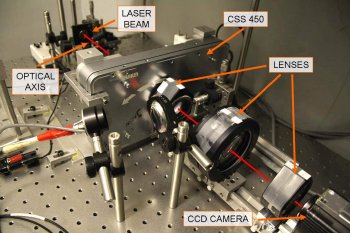Market leaders in temperature controlled microscopy, Linkam Scientific Instruments report on the use of their CSS450 optical shearing system at the University of Montpellier 2.
 Linkam CSS450 stage at the University of Montpellier 2.
Linkam CSS450 stage at the University of Montpellier 2.
At the University of Montpellier 2, the Colloidal Metallurgy team (PI: Laurence Ramos, CNRS scientist) is designing a system (using polymers and colloids) that will permit a better understanding of the mechanical and plastic properties of polycrystals. The aim is to relate the macroscopic mechanical properties to the microscopic texture of the polycrystal. The team will use a combination of advanced experimental techniques, including light and neutron scattering, optical microscopy and rheology. Elisa Tamborini, a PhD student with the group, commented that the benefit of using the Linkam stage is that the researchers can "directly "see" the sample under shear."
The developed colloidal model is made up of micelles formed from a commercial molecule: Pluronic F108 block copolymer. In aqueous solutions at high concentration, these copolymers self-assemble into micelles with the hydrophobic blocks forming the core, separated from the aqueous exterior by the hydrophilic chains. If the number of formed micelles is sufficiently high, they self-assemble to form a crystalline phase. Micelles are therefore the equivalent of atoms in an atomic crystal, except that they are two orders of magnitude larger.
The colloidal system is transparent and so is observable with both confocal microscopy and light scattering. Using small-angle neutron scattering (SANS), the team investigates the structure of the crystal and a small amount of silica nanoparticles. The polycrystal samples are spatially heterogeneous and comprise silica-poor and silica-rich regions. These silica-rich regions are grain boundaries (GBs) between crystallites, where the nanoparticles concentrate. During crystallization, silica nanoparticles are expelled from the crystal lattice and fill the GBs.
By combining the visualization of the 3D GB structure and mechanical measurements (confocal microscopy + Linkam CSS 450), the group is able to collect space-time resolved information on the local dynamics of the crystallite organization under an applied shear strain. Additional measurements are obtained from an apparatus that combines a space-time resolved dynamic light scattering method with simultaneous mechanical measurements (light scattering setup + Linkam CSS 450). In both cases, by varying the crystallization rate, the team will be able to investigate how the mechanisms at play depend on the crystallites' size. As they will have access to the local shear deformation, stress and GB dynamics, they expect to explain the different microscopic mechanisms at work in the plasticity and behaviour of polycrystals.